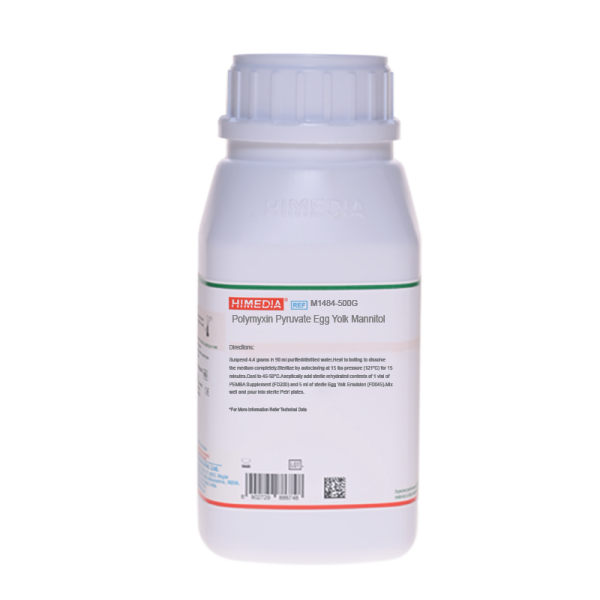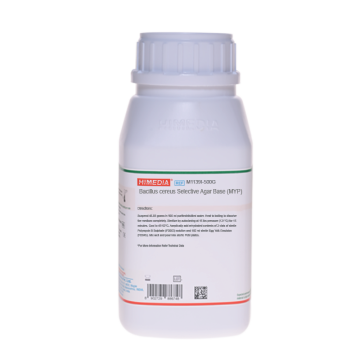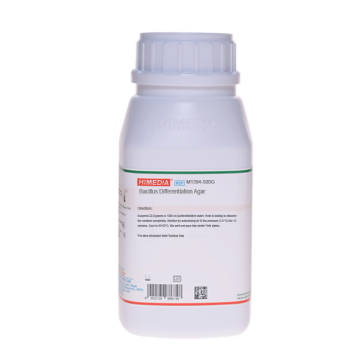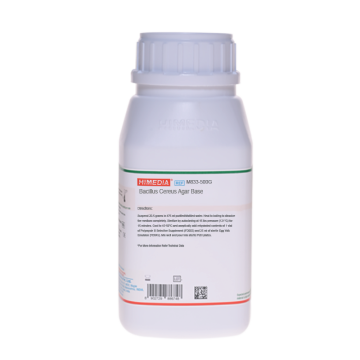 Your enquiry has been submitted
Your enquiry has been submitted
Polymyxin Pyruvate Egg Yolk Mannitol Bromothymol Blue Agar Base (PEMBA)
Intended Use
Recommended for the cultivation of Bacillus cereus. The composition and performance criteria of this medium are as per the specifications laid down in ISO 21871:2006
Composition
| Ingredients | g / 100 ml |
|---|---|
| Peptone | 0.100 |
| Mannitol | 1.000 |
| Sodium pyruvate | 1.000 |
| Disodium hydrogen phosphate | 0.250 |
| Sodium chloride | 0.200 |
| Potassium dihydrogen phosphate | 0.025 |
| Magnesium sulphate heptahydrate | 0.010 |
| Bromo thymol blue | 0.010 |
| Agar | 1.800 |
Final pH (at 25°C): 7.4±0.2
**Formula adjusted, standardized to suit performance parameters
Directions
Suspend 4.39 gram in 90 ml purified / distilled water. Heat to boiling to dissolve the medium completely. Sterilize by autoclaving at 15 lbs pressure (121°C) for 15 minutes. Cool to 45-50°C. Aseptically add sterile rehydrated contents of 1 vial PEMBA Supplement (FD200) and 5 ml of sterile Egg Yolk Emulsion (FD045). Mix well and pour into sterile Petri plates.
Principle And Interpretation
Bacillus cereus is an aerobic spore-forming bacteria commonly found in soil and isolated from different vegetables, raw and processed foods. B.cereus causes food poisoning due to the consumption of contaminated raw vegetables, sprouts, meat, custards, soups, boiled or fried rice (1-3). It also causes eye infections and a wide range of other clinical conditions like abscess formation, meningitis, septicaemia and wound infection. B.cereus is a known cause of mastitis, especially in ewes and heifers (4). Polymyxin Pyruvate Egg Yolk Mannitol Bromothymol Blue Agar (PEMBA), formulated as per Holbrook and Anderson (4), is a highly specific, selective medium for the isolation and enumeration of B.cereus from foods (1,5). This medium is also recommended by ISO (6,7) Selectivity is attained with polymyxin and a critical concentration of nutrients (4). It supports the growth of even a small number of B.cereus cells and spores from foods having large number of microbial load. The low peptone content in the medium promotes sporulation and sodium pyruvate reduces the colony size of the organisms. Egg yolk emulsion demonstrates the strong lecithinase opacity reaction. Bromothymol blue acts as pH indicator to detect mannitol fermentation.
Addition of polymyxin B sulphate (8,9) at a final concentration of 100 units per ml of medium is sufficient to make the medium selective for the isolation of B.cereus. Cycloheximide (4mg/ l) may be used to inhibit the growth of moulds. Some strains of B.cereus have very weak egg yolk reaction. Moreover, on this medium B.cereus is indistinguishable from B. thuringiensis. B.cereus forms crenated blue colonies surrounded by a zone of opacity in the medium.
Type of specimen
Food and dairy samples
Specimen Collection and Handling
For food and dairy samples, follow appropriate techniques for sample collection and processing as per guidelines (1-3,6,7). After use, contaminated materials must be sterilized by autoclaving before discarding
Warning and Precautions
Read the label before opening the container. Wear protective gloves/protective clothing/eye protection/ face protection. Follow good microbiological lab practices while handling specimens and culture. Standard precautions as per established guidelines should be followed while handling specimens. Safety guidelines may be referred in individual safety data sheets.
Limitations
- Individual organisms differ in their growth requirement and may show variable growth patterns on the medium.
- Each lot of the medium has been tested for the organisms specified on the COA. It is recommended to users to validate the medium for any specific microorganism other than mentioned in the COA based on the user’s unique requirement.
- Bacillus cereus and Bacillus thuringiensis shows identical characteristics and hence difficult to identify.
- Identification of Bacillus cereus is done by colony characteristics and reaction, however further biochemical characteristics should be carried out for confirmation.
- Some strains of B. cereus have very weak egg yolk reaction.
Performance and Evaluation
Performance of the medium is expected when used as per the direction on the label within the expiry period when stored at recommended temperature.
Quality Control
Appearance: Cream to greenish yellow homogeneous free flowing powder
Gelling: Firm, comparable with 1.8% Agar gel
Colour and Clarity of prepared medium: Basal medium :Green coloured clear to slightly opalescent gel. After addition of Egg Yolk Emulsion : Forest green coloured, opaque gel forms in Petri plates
Reaction: Reaction of 4.4% w/v aqueous solution (basal medium) at 25°C. pH : 7.4±0.2
pH: 7.20-7.60
Cultural Response
Productivity: Cultural characteristics observed with added PEMBA (FD200) and Egg Yolk Emulsion (FD045), after an incubation at 37 ± 1°C for 21 ± 3 hours to 44 ± 4 hours. Recovery rate is considered as 100% for bacteria growth on Reference Medium - Soyabean Casein Digest Agar (Tryptone Soya Agar)
Selectivity: Cultural characteristics observed with added PEMBA (FD200) and Egg Yolk Emulsion (FD045), after an incubation at 37 ± 1°C for 44 ± 4 hours.
Specificity: Cultural characteristics observed with added PEMBA (FD200) and Egg Yolk Emulsion (FD045), after an incubation at 37 ± 1°C for 44 ± 4 hours.
| Organism | Inoculum (CFU) | Growth | Recovery | Characteristic reaction |
|---|---|---|---|---|
| Bacillus cereus ATCC 11778 (00001*) | 50-100 | good-luxuriant | >=50% | turquose - blue colonies with precipitation halo |
| Escherichia coli ATCC 25922 (00013*) | >=10^4 | inhibited | - | - |
| Escherichia coli ATCC 8739 (00012*) | >=10^4 | inhibited | - | - |
| $Bacillus spizizenii ATCC 6633 (00003*) | 50-100 | good-luxuriant | - | white colonies without precipitation halo |
Key : * - Corresponding WDCM numbers $ Formerly known as Bacillus subtilis subsp. spizizenii
Storage and Shelf Life
Store between 10-30°C in a tightly closed container and the prepared medium at 2-8°C. Use before expiry date on the label. On opening, product should be properly stored dry, after tightly capping the bottle in order to prevent lump formation due to the hygroscopic nature of the product. Improper storage of the product may lead to lump formation. Store in dry ventilated area protected from extremes of temperature and sources of ignition Seal the container tightly after use. Product performance is best if used within stated expiry period.
Disposal
User must ensure safe disposal by autoclaving and/or incineration of used or unusable preparations of this product. Follow established laboratory procedures in disposing of infectious materials and material that comes into contact with sample must be decontaminated and disposed of in accordance with current laboratory techniques (13,14).
Reference
- Bouza E., Grant S., Jordan C. et al, 1979, arch. Ophthalmol., 97:488.
- Mortimer P. R. and McCann G., 1974, Lancet, 104:3.
- Wohlegmuth K., Kirkbride C. A., Bicknell E. J. and Ellis R. P., 1972, Am. Vet. Med. Ass., 161:1691.
- Hollbrook R., Anderson J. M., 1980, Canadian Journal of Microbiology 26:753-759
- Corry J. E. L., Curtis G. D. W. and Baird R. M., (Eds.), Culture Media for Food Microbiology. Vol. 34,1995, Elsevier, Amsterdam
- Microbiology of food,animal feeding stuffs and water- Preparation, production,storage and performance testing of culture media, EN ISO 11133:2014 (E) /Amd. :2020.
- Microbiology of food and animal feeding stuffs - Horizontal method for the determination of low numbers of presumptive Bacillus cereus - Most probable number technique and detection method. ISO 21871:2006-04
- Donovan K. O., 1958, J. Appl. Bacteriol., 21(1):100.
- Mossel D. A. A., Koopman J. and Jongerius E., 1967, J. Appl. Micorbiol., 15(3):650.
- American Public Health Association, Standard Methods for the Examination of Dairy Products, 1978, 14th Ed., Washington D.C.
- Salfinger Y., and Tortorello M.L. Fifth (Ed.), 2015, Compendium of Methods for the Microbiological Examination of Foods, 5th Ed., American Public Health Association, Washington, D.C.
- Wehr H. M. and Frank J. H., 2004, Standard Methods for the Microbiological Examination of Dairy Products, 17th Ed., APHA Inc., Washington, D.C.
- Isenberg, H.D. Clinical Microbiology Procedures Handbook 2nd Edition.
- Jorgensen, J.H., Pfaller, M.A., Carroll, K.C., Funke, G., Landry, M.L., Richter, S.S and Warnock., D.W. (2015) Manual of Clinical Microbiology, 11th Edition. Vol. 1.
| Product Name | Polymyxin Pyruvate Egg Yolk Mannitol Bromothymol Blue Agar Base (PEMBA) |
|---|---|
| SKU | M1484 |
| Product Type | Regular |
| Physical Form | Powder |
| Origin | Animal |
| Packaging type | HDPE |
| References | 1. Mortimer P. R. and McCann G., 1974, Lancet, 104:3. |
| Customized Product Available | No |










